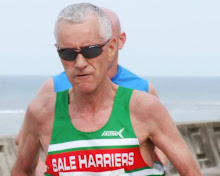I don't know about you but I hate the cold. At 5'11 and weighing less than 10 stone there's not exactly a lot of flab around my oldbones to keep me warm. I'm sat here with the house heating just coming on, a supplementary room heater and a blanket round my legs.
I certainly believe in protecting myself when I go running in zero degrees or thereabouts.
Winter Windstopper tights, good baselayer, Windstopper Softshell jacket for me!
I once remember raising a lot of eyebrows and prompted quite a few quips back in 1987 when I ran the Preston 10 in a pair of plain black lycra tights. I thought heck I wouldn't train in shorts in freezing conditions (although it was March 1st) so why not? Didn't seem to slow me down much as I ran the 10 miler in 52.30.
I was surprised when I saw quite a lot of runners jogging to the start last Sunday wearing just what they would wear for a race in July. There was no snow as previously reported but there was bitingly cold north easterly which worsened as the morning went on.
Thankfully though it remained dry but what can happen when conditions deteriorate rapidly? It can happen.
A cross country event which began with warm, March sunshine late morning ended in fatal consequences with officials dying from hypothermia as rain, sleet and snow came in throughout the afternoon with severe and sudden drop in temperature.
Athletes have complained bitterly this week about the cancellation of the Southern Cross Country Championships which were due to take place at Parliament Hill tomorrow. I have read arguments for and against the cancellation but read nothing about the plight of officials manning the course and the finishing pens if conditions are severe.
Last Sunday I made a point of thanking marshalls for standing out in the cold, as did several other competitors. Standing in the spot for over 3 hours is not an eviable task even in the summer.
If the Northern Cross Country does go ahead tomorrow at Knowsley I hope athletes will protect themselves. Young ladies particularly seem vulnerable as they seem to think running around in a pair skimpy briefs and a crop top is a good idea.
"Hey, look at me I'm fast, I'm an elite athlete, I'm too fast to suffer hypothermia!!!
Compare the approach of GEMMA STEEL compared with FIONNUALA BRITTON.
Fionnuala is unbeatable on the country in Europe this winter, of course!
I was curious to read more about HYPOTHERMIA (the opposite of HYPERTHERMIA) its cause and its effects.
INTERESTING.........
The generally recognized risk factors associated with the potential for hypothermia include:
- Low air temperatures, often combined with inadequate clothing or protection; the reflex action of the body to cold exposure is to shiver, an involuntary effort to generate heat.
- Wind chill, the combined effect of temperature and wind on the human body; wind chill is a deceptive phenomenon, as it may occur in all types of cold weather environments, including sunshine. As a general proposition, at temperatures below 40°F (4°C), winds at speeds as low as 5 mph (8 km/h) can significantly induce increased sensations of cold; the greater the wind speed, the more pronounced the effect of cold will be.
- Moisture; skin that is wet, though either excess perspiration or environmental effects, will freeze more readily than dry skin. Moisture will also magnify the effect of wind chill.
- Consumption of alcohol, which tends to stimulate blood flow in the peripheral parts of the body, an action that contributes to heat loss.
- Amount of skin exposed to the elements by the athlete; exposed skin permits heat to be lost by both convection and radiation to the immediate environment.
- Consumption of caffeine or any other diuretic, which acts to reduce fluid volumes in the cardiovascular system.
In its mildest manifestation, hypothermia causes pronounced shivering, numbness, and a cold feeling through out the body. As the body temperature remains low, the symptoms become more pronounced, as the person will experience an inability to move quickly or decisively, accompanied by dizziness and confused thinking. At its most extreme, the affected person will experience a rigidity of the muscles, followed by a lapse into coma. At a body temperature of less than 95°F (35°C), the person must receive immediate attention or, as a result of a progressive decline in the function of the organs and the internal systems, death will result.
In short, if you go out on a Friday night...... have a few drinks with your mates, .......try to sober up the next day by drinking coffee ......then race in the Saturday afternoon on a cold winter's day wearing nothing but a crop top and knickers or even a vest and split shorts .......and it begins to rain
YOU COULD WELL END UP IN HOSPITAL!!












Totally agree. Lack of responsibility and relying on others to look after you should you succumb.
ReplyDeleteJust wrote a little piece about staying safe whilst running. More for hill runners but relevant none the less.
http://fellrunningguide.blogspot.co.uk/2013/01/whats-in-bag.html
Couldn't agree more Terry. My rule of thumb is: Run in tightsd until the air temperature hits double figures! A bit rough and ready, but it works for me. Another thing to add to the list of risk factors is altitude. What's a pleasantly cool breeze at the start in the valley can be lethally chilly higher up.
ReplyDelete